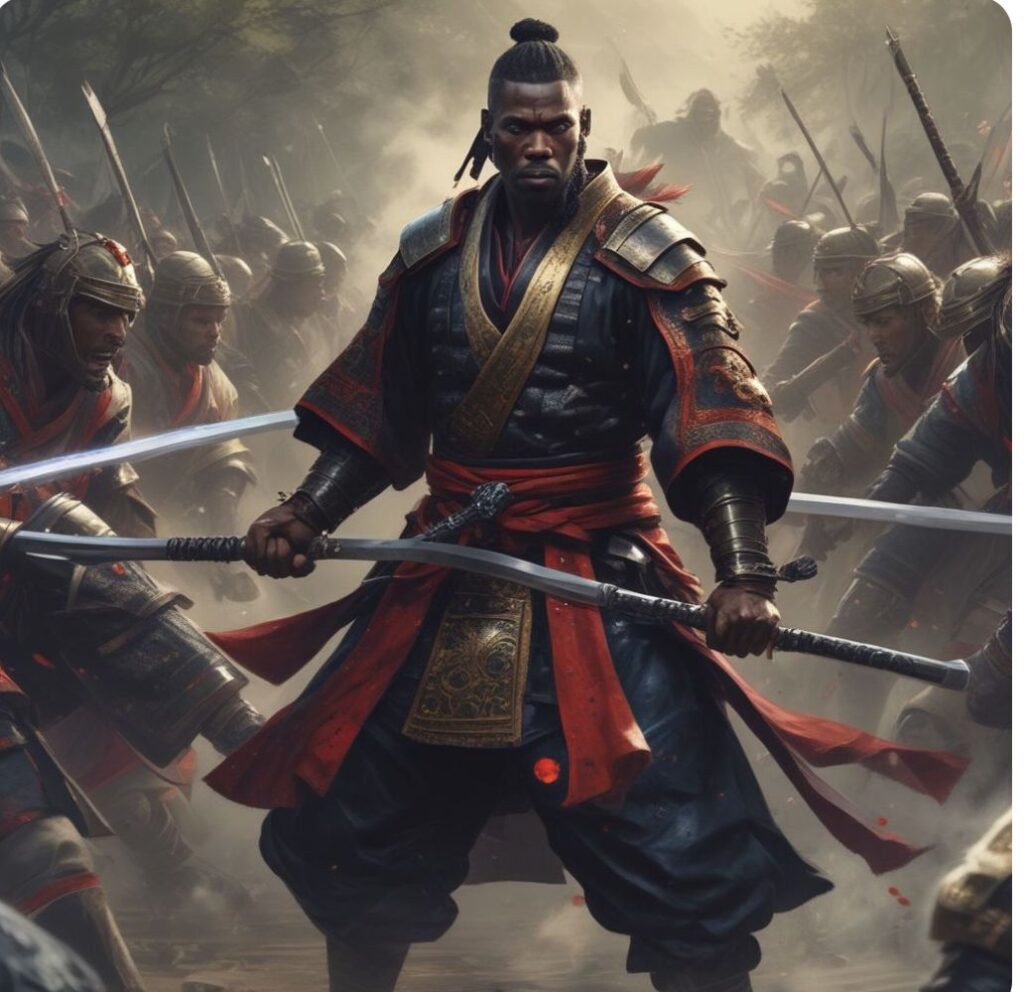Black History and Cross-Cultural Encounters.
The African Samurai: Yasuke's Rise in Feudal Japan
“Meet Yasuke, the African warrior who defied all odds to become Japan's first foreign-born samurai. His journey from the heart of Africa to the battlefields of feudal Japan is a story of bravery, honor, and an extraordinary cultural exchange that changed history. Dive into the legend of Yasuke and discover how he broke barriers and left an indelible mark on Japanese history.”
BWSMCONTRIBUTOR
The Samurai from a Distant Land
In the year 1581, a procession wound its way through the bustling streets of Miyako, the imperial capital of Japan. The city buzzed with excitement and anticipation, a sea of curious faces jostling to catch a glimpse of a man who had become the talk of the town.
It was not the famed Jesuit missionary Alessandro Valignano who drew such attention, nor the grand entourage that accompanied him, but rather a single figure who walked at his side—a man unlike any the people of Miyako had ever seen. Towering over the crowd, with skin dark as night and a presence that radiated strength and mystery, he was Yasuke, the African who would soon rise to an extraordinary place in Japanese history.

Yasuke’s origins remain shrouded in mystery, like a half-remembered dream of a distant land. Born around 1555, he may have hailed from the region now known as South Sudan, or perhaps from Mozambique, a land claimed by the Portuguese who would come to influence much of his early life. Descriptions by those who encountered him speak of a man of impressive stature and physical prowess, but it is in Japan that his story truly begins.
Yasuke first stepped onto Japanese soil in May 1579, arriving with Valignano at the port of Kuchinotsu in Nagasaki prefecture. The country was in the throes of civil war, a land of shifting allegiances and clashing swords. For two years, Yasuke served as Valignano’s bodyguard, a silent sentinel at the side of the Jesuit as he navigated the treacherous waters of Japanese politics and religion.
It was in the early months of 1581, however, that Yasuke’s fate would take a dramatic turn. As Valignano prepared to leave Japan, he sought an audience with the most powerful man in the country, the warlord Oda Nobunaga. The journey to Miyako was fraught with danger, and Yasuke’s presence caused a sensation wherever they went. In Sakai, the crowd’s excitement was so intense that buildings were damaged, and in Miyako, the crush of people led to deaths as they clamored to see the man who seemed to them more a myth than reality.
Nobunaga, a shrewd and curious leader, ordered Yasuke to be brought before him, intrigued by the tales of this extraordinary visitor.
The first meeting between the African warrior and the Japanese warlord is recorded in the Shinchōkōki, a chronicle by Ōta Gyūichi. Yasuke’s height, strength, and demeanor impressed Nobunaga, but the warlord was suspicious of the man’s dark skin, believing it to be painted on. When it became clear that Yasuke’s appearance was natural, Nobunaga’s interest deepened.
He welcomed Yasuke into his inner circle, bestowing upon him a house, servants, a stipend, and even a sword—symbols of the samurai class. Whether Yasuke was officially made a samurai is a matter of debate, but there is no doubt that he became a trusted member of Nobunaga’s retinue.
Yasuke’s life at Nobunaga’s side was one of honor and privilege, a far cry from the unknown origins of his past. The Jesuit Lourenço Mexia, who was also in Nobunaga’s capital city of Azuchi, noted the warlord’s fondness for Yasuke and even reported rumors that the African might be granted a fief of his own—a rare honor indeed.

In the spring of 1582, Yasuke accompanied Nobunaga on a military campaign against Takeda Katsuyori in the Kōshū region. Victorious, they returned to Azuchi, where Yasuke’s presence was noted by Matsudaira Ietada, a vassal of Tokugawa Ieyasu, who recorded Yasuke’s height and confirmed that he had been granted a stipend—a clear sign of Nobunaga’s favor.
But the peace would not last. On the night of June 21, 1582, Yasuke’s world was shattered. As Nobunaga and his closest retainers slept at the Honnō-ji temple in Miyako, they were awakened by the sound of gunfire and the smell of smoke. Akechi Mitsuhide, one of Nobunaga’s own vassals, had betrayed him, launching a surprise attack with an army of thousands. Nobunaga, realizing escape was impossible, chose to end his own life in the ritual of seppuku rather than be captured.
Yasuke, ever loyal, did not flee. He fought alongside Nobunaga’s son, Nobutada, in a desperate last stand at the Nijō-goshō imperial villa. The battle was fierce, but Mitsuhide’s forces were overwhelming. Nobutada fell, and Yasuke was captured.
Mitsuhide, however, saw Yasuke not as a defeated samurai but as something other, something foreign. He spared Yasuke’s life, perhaps out of a mixture of curiosity and contempt, and sent him to the Jesuits who had brought him to Japan. The Jesuits, who had feared for Yasuke’s life, gave thanks for his survival. And then, as suddenly as he had appeared in the pages of history, Yasuke vanished.
The last confirmed record of Yasuke is a simple note of gratitude from the Jesuits for his safe return. What became of him after that remains unknown. Did he return to Africa, or perhaps to India, where his journey to Japan had begun? Or did he remain in Japan, a silent witness to the tides of history that he had once ridden so boldly?
Yasuke’s legacy lives on in fragments of historical documents, in the tales told by those who knew him, and in the art that depicts him. In the early 17th century, a folding screen was painted, showing a tall African man wrestling with a Japanese opponent, surrounded by onlookers—one of whom might be Oda Nobunaga himself. The image captures a moment of Yasuke’s life, a memory of the samurai from a distant land who walked among the lords of Japan.
He remains an enigma, a figure of both history and legend, his story a testament to the extraordinary journeys that can unfold when different worlds collide.





















































